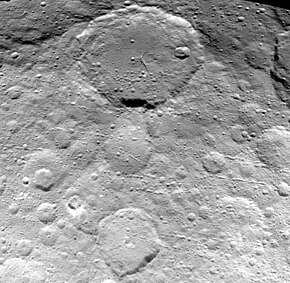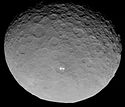
Vesta is one of the largest objects in the asteroid belt, with a mean diameter of 525 kilometres (326 mi). It was discovered by the German astronomer Heinrich Wilhelm Matthias Olbers on 29 March 1807 and is named after Vesta, the virgin goddess of home and hearth from Roman mythology.

Ceres is a dwarf planet in the middle main asteroid belt between the orbits of Mars and Jupiter. It was the first known asteroid, discovered on 1 January 1801 by Giuseppe Piazzi at Palermo Astronomical Observatory in Sicily, and announced as a new planet. Ceres was later classified as an asteroid and then a dwarf planet, the only one inside Neptune's orbit.
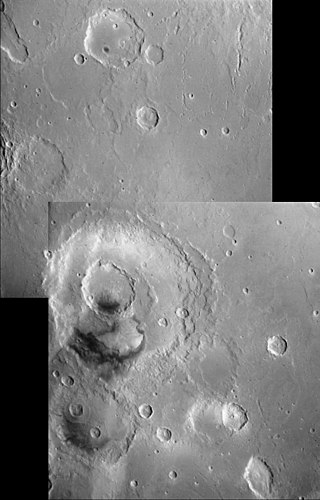
Becquerel is a 167 km-diameter crater at 22.1°N, 352.0°E on Mars, in Arabia Terra in Oxia Palus quadrangle. It is named after Antoine H. Becquerel.

Kuiper is a moderate-size crater with a central peak cluster located at 11.35°S 31.23°W on Mercury. It is 62 kilometers in diameter and was named after Dutch-American astronomer Gerard Kuiper in 1976. It is one of only 2 Mercurian craters which are named not after artists, and one of very few cases when the same name is used for 3 craters. Gerard Kuiper, being a leader of American planetary science, died shortly before the first images of Mercurian surface were made.
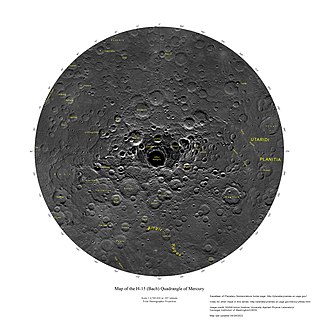
The Bach quadrangle encompasses the south polar part of Mercury poleward of latitude 65° S. It is named after the prominent crater Bach within the quadrangle, which is in turn named after Baroque composer Johann Sebastian Bach. The quadrangle is now called H-15.

The Discovery quadrangle lies within the heavily cratered part of Mercury in a region roughly antipodal to the 1550-km-wide Caloris Basin. Like the rest of the heavily cratered part of the planet, the quadrangle contains a spectrum of craters and basins ranging in size from those at the limit of resolution of the best photographs to those as much as 350 km across, and ranging in degree of freshness from pristine to severely degraded. Interspersed with the craters and basins both in space and time are plains deposits that are probably of several different origins. Because of its small size and very early segregation into core and crust, Mercury has seemingly been a dead planet for a long time—possibly longer than the Moon. Its geologic history, therefore, records with considerable clarity some of the earliest and most violent events that took place in the inner Solar System.

Puńsk is an impact crater on Mars, located in the Oxia Palus quadrangle at 20.8° N and 41.2° W. It measures 11.6 kilometers in diameter and was named after the village of Puńsk in Poland.

Martian gullies are small, incised networks of narrow channels and their associated downslope sediment deposits, found on the planet of Mars. They are named for their resemblance to terrestrial gullies. First discovered on images from Mars Global Surveyor, they occur on steep slopes, especially on the walls of craters. Usually, each gully has a dendritic alcove at its head, a fan-shaped apron at its base, and a single thread of incised channel linking the two, giving the whole gully an hourglass shape. They are estimated to be relatively young because they have few, if any craters. A subclass of gullies is also found cut into the faces of sand dunes, that are themselves considered to be quite young. Linear dune gullies are now considered recurrent seasonal features.

Occator is an impact crater located on Ceres, the largest object in the main asteroid belt that lies between the orbits of Mars and Jupiter, that contains "Spot 5", the brightest of the bright spots observed by the Dawn spacecraft. It was known as "Region A" in ground-based images taken by the W. M. Keck Observatory on Mauna Kea.
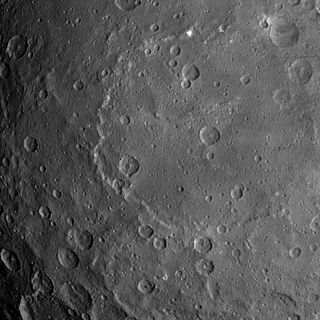
Kerwan is the largest confirmed crater and one of the largest geological features on Ceres. It was discovered on February 19, 2015 from Dawn images as it approached Ceres. The crater is distinctly shallow for its size, and lacks a central peak. A central peak might have been destroyed by a 15-kilometer-wide crater at the center of Kerwan. The crater is likely to be young relative to the rest of Ceres's surface, as Kerwan has largely obliterated the cratering in the southern part of Vendimia Planitia.
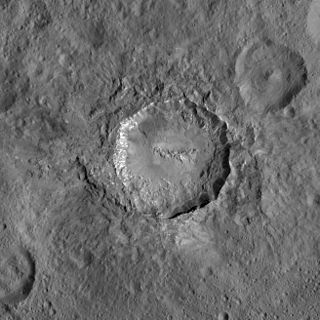
Haulani is an impact crater located on Ceres that contains "Spot 1", one of the bright spots observed by the Dawn spacecraft. The crater was named after Haulani, the Hawaiian goddess of plants. In July 2018, NASA released a comparison of physical features, including Haulani crater, found on Ceres with similar ones present on Earth.

Vulcan Planitia, or Vulcan Planum, is the unofficial name given to a large plain on the southern hemisphere of Pluto's moon Charon. It discovered by New Horizons during its flyby of Pluto in July 2015. It is named after the fictional planet Vulcan in the science-fiction series Star Trek. The name is not approved by International Astronomical Union (IAU) as of 2024.

Coniraya is a large, shallow crater on the dwarf planet Ceres. It is the namesake for the Coniraya Quadrangle.

Dantu is a large crater on Ceres, located within the Vendimia Planitia. It is rimmed by a number of minor faculae, which together form Bright Spot 2.

Fejokoo is a crater on the dwarf planet Ceres. Like all craters on Ceres, it is named after an agricultural deity; the crater is named for the Igbo deity who provided yams. The name was officially approved by the International Astronomical Union (IAU) on 3 July 2015, shortly after Dawn had entered Ceres orbit. Fejokoo Crater is the namesake for the Fejokoo Quadrangle.

The geology of Ceres consists of the characteristics of the surface, the crust and the interior of the dwarf planet Ceres. The surface of Ceres is comparable to the surfaces of Saturn's moons Rhea and Tethys, and Uranus's moons Umbriel and Oberon.

Achita is a large crater on Ceres.

Sintana is a large central peak crater in the Southern Hemisphere of the dwarf planet Ceres, located at 44.21° S, 76.4 ° E. It has a diameter of 58 km. The crater is named after the deity of the Kogi people of northern Colombia who produced fertile black earth. It was officially named by the International Astronomical Union (IAU) on July 3, 2015. It is the namesake of the Sintana Quadrangle.

Dorothy Crater is the largest known impact basin on Pluto's moon Charon. The crater was discovered by the New Horizons space probe in 2015 during its flyby of Pluto and its moons. It was named after Dorothy Gale from the novel The Wonderful Wizard of Oz. The crater is located near Charon's north pole, and overlaps the edge of Mordor Macula.
